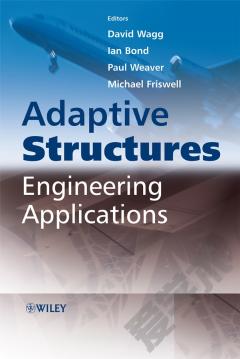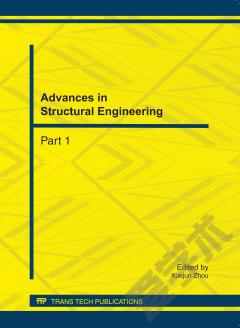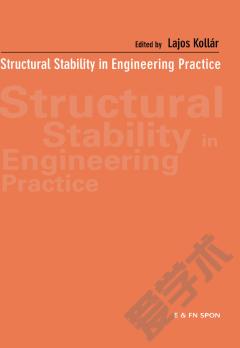Adaptive Structures —— Engineering Applications
----- 自适应结构:工程应用
List of Contributors. Preface. 1 Adaptive Structures for Structural Health Monitoring (Daniel J. Inman and Benjamin L. Grisso). 1.1 Introduction. 1.2 Structural Health Monitoring. 1.3 Impedance-Based Health Monitoring. 1.4 Local Computing. 1.5 Power Analysis. 1.6 Experimental Validation. 1.7 Harvesting, Storage and Power Management. 1.8 Autonomous Self-healing. 1.9 The Way Forward: Autonomic Structural Systems for Threat Mitigation. 1.10 Summary. Acknowledgements. References. 2 Distributed Sensing for Active Control (Suk-Min Moon, Leslie P. Fowler and Robert L. Clark). 2.1 Introduction. 2.2 Description of Experimental Test Bed. 2.3 Disturbance Estimation. 2.4 Sensor Selection. 2.5 Conclusions. Acknowledgments. References. 3 Global Vibration Control Through Local Feedback (Stephen J. Elliott). 3.1 Introduction. 3.2 Centralised Control of Vibration. 3.3 Decentralised Control of Vibration. 3.4 Control of Vibration on Structures with Distributed Excitation. 3.5 Local Control in the Inner Ear. 3.6 Conclusions. Acknowledgements. References. 4 Lightweight Shape-Adaptable Airfoils: A New Challenge for an Old Dream (L.F. Campanile). 4.1 Introduction. 4.2 Otto Lilienthal and the Flying Machine as a Shape-Adaptable Structural System. 4.3 Sir George Cayley and the Task Separation Principle. 4.4 Being Lightweight: A Crucial Requirement. 4.5 Coupling Mechanism and Structure: Compliant Systems as the Basis of Lightweight Shape-Adaptable Systems. 4.6 Extending Coupling to the Actuator System: Compliant Active Systems. 4.7 A Powerful Distributed Actuator: Aerodynamics. 4.8 The Common Denominator: Mechanical Coupling. 4.9 Concluding Remarks. Acknowledgements. References. 5 Adaptive Aeroelastic Structures (Jonathan E. Cooper). 5.1 Introduction. 5.2 Adaptive Internal Structures. 5.3 Adaptive Stiffness Attachments. 5.4 Conclusions. 5.5 The Way Forward. Acknowledgements. References. 6 Adaptive Aerospace Structures with Smart Technologies - A Retrospective and Future View (Christian Boller). 6.1 Introduction. 6.2 The Past Two Decades. 6.3 Added Value to the System. 6.4 Potential for the Future. 6.5 A Reflective Summary with Conclusions. References. 7 A Summary of Several Studies with Unsymmetric Laminates (Michael W. Hyer, Marie-Laure Dano, Marc R. Schultz, Sontipee Aimmanee and Adel B. Jilani). 7.1 Introduction and Background. 7.2 Room-Temperature Shapes of Square [02/902]T Cross-Ply Laminates. 7.3 Room-Temperature Shapes of More General Unsymmetric Laminates. 7.4 Moments Required to Change Shapes of Unsymmetric Laminates. 7.5 Use of Shape Memory Alloy for Actuation. 7.6 Use of Piezoceramic Actuation. 7.7 Consideration of Small Piezoceramic Actuators. 7.8 Conclusions. References. 8 Negative Stiffness and Negative Poisson's Ratio in Materials which Undergo a Phase Transformation (T.M. Jaglinski and R.S. Lakes). 8.1 Introduction. 8.2 Experimental Methods. 8.3 Composites. 8.4 Polycrystals. 8.5 Discussion. References. 9 Recent Advances in Self-Healing Materials Systems (M.W. Keller, B.J. Blaiszik, S.R. White and N.R. Sottos). 9.1 Introduction. 9.2 Faster Healing Systems - Fatigue Loading. 9.3 Smaller Size Scales. 9.4 Alternative Materials Systems - Elastomers. 9.5 Microvascular Autonomic Composites. 9.6 Conclusions. References. 10 Adaptive Structures - Some Biological Paradigms (Julian F.V. Vincent). 10.1 Introduction. 10.2 Deployment. 10.3 Turgor-Driven Mechanisms. 10.4 Dead Plant Tissues. 10.5 Morphing and Adapting in Animals. 10.6 Sensing in Arthropods - Campaniform and Slit Sensilla. 10.7 Developing an Interface Between Biology and Engineering. 10.8 Envoi. Acknowledgements. References. Index.
{{comment.content}}








 京公网安备 11010802027623号
京公网安备 11010802027623号